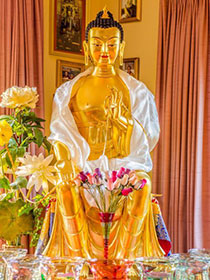- Home
- FPMT Homepage
Foundation for the Preservation of the Mahayana Tradition
The FPMT is an organization devoted to preserving and spreading Mahayana Buddhism worldwide by creating opportunities to listen, reflect, meditate, practice and actualize the unmistaken teachings of the Buddha and based on that experience spreading the Dharma to sentient beings. We provide integrated education through which people’s minds and hearts can be transformed into their highest potential for the benefit of others, inspired by an attitude of universal responsibility and service. We are committed to creating harmonious environments and helping all beings develop their full potential of infinite wisdom and compassion. Our organization is based on the Buddhist tradition of Lama Tsongkhapa of Tibet as taught to us by our founders Lama Thubten Yeshe and Lama Thubten Zopa Rinpoche.
- Willkommen
Die Stiftung zur Erhaltung der Mahayana Tradition (FPMT) ist eine Organisation, die sich weltweit für die Erhaltung und Verbreitung des Mahayana-Buddhismus einsetzt, indem sie Möglichkeiten schafft, den makellosen Lehren des Buddha zuzuhören, über sie zur reflektieren und zu meditieren und auf der Grundlage dieser Erfahrung das Dharma unter den Lebewesen zu verbreiten.
Wir bieten integrierte Schulungswege an, durch denen der Geist und das Herz der Menschen in ihr höchstes Potential verwandelt werden zum Wohl der anderen – inspiriert durch eine Haltung der universellen Verantwortung und dem Wunsch zu dienen. Wir haben uns verpflichtet, harmonische Umgebungen zu schaffen und allen Wesen zu helfen, ihr volles Potenzial unendlicher Weisheit und grenzenlosen Mitgefühls zu verwirklichen.
Unsere Organisation basiert auf der buddhistischen Tradition von Lama Tsongkhapa von Tibet, so wie sie uns von unseren Gründern Lama Thubten Yeshe und Lama Thubten Zopa Rinpoche gelehrt wird.
- Bienvenidos
La Fundación para la preservación de la tradición Mahayana (FPMT) es una organización que se dedica a preservar y difundir el budismo Mahayana en todo el mundo, creando oportunidades para escuchar, reflexionar, meditar, practicar y actualizar las enseñanzas inconfundibles de Buda y en base a esa experiencia difundir el Dharma a los seres.
Proporcionamos una educación integrada a través de la cual las mentes y los corazones de las personas se pueden transformar en su mayor potencial para el beneficio de los demás, inspirados por una actitud de responsabilidad y servicio universales. Estamos comprometidos a crear ambientes armoniosos y ayudar a todos los seres a desarrollar todo su potencial de infinita sabiduría y compasión.
Nuestra organización se basa en la tradición budista de Lama Tsongkhapa del Tíbet como nos lo enseñaron nuestros fundadores Lama Thubten Yeshe y Lama Zopa Rinpoche.
A continuación puede ver una lista de los centros y sus páginas web en su lengua preferida.
- Bienvenue
L’organisation de la FPMT a pour vocation la préservation et la diffusion du bouddhisme du mahayana dans le monde entier. Elle offre l’opportunité d’écouter, de réfléchir, de méditer, de pratiquer et de réaliser les enseignements excellents du Bouddha, pour ensuite transmettre le Dharma à tous les êtres. Nous proposons une formation intégrée grâce à laquelle le cœur et l’esprit de chacun peuvent accomplir leur potentiel le plus élevé pour le bien d’autrui, inspirés par le sens du service et une responsabilité universelle. Nous nous engageons à créer un environnement harmonieux et à aider tous les êtres à épanouir leur potentiel illimité de compassion et de sagesse. Notre organisation s’appuie sur la tradition guéloukpa de Lama Tsongkhapa du Tibet, telle qu’elle a été enseignée par nos fondateurs Lama Thoubtèn Yéshé et Lama Zopa Rinpoché.
Visitez le site de notre Editions Mahayana pour les traductions, conseils et nouvelles du Bureau international en français.
Voici une liste de centres et de leurs sites dans votre langue préférée
- Benvenuto
L’FPMT è un organizzazione il cui scopo è preservare e diffondere il Buddhismo Mahayana nel mondo, creando occasioni di ascolto, riflessione, meditazione e pratica dei perfetti insegnamenti del Buddha, al fine di attualizzare e diffondere il Dharma fra tutti gli esseri senzienti.
Offriamo un’educazione integrata, che può trasformare la mente e i cuori delle persone nel loro massimo potenziale, per il beneficio di tutti gli esseri, ispirati da un’attitudine di responsabilità universale e di servizio.
Il nostro obiettivo è quello di creare contesti armoniosi e aiutare tutti gli esseri a sviluppare in modo completo le proprie potenzialità di infinita saggezza e compassione.
La nostra organizzazione si basa sulla tradizione buddhista di Lama Tsongkhapa del Tibet, così come ci è stata insegnata dai nostri fondatori Lama Thubten Yeshe e Lama Zopa Rinpoche.
Di seguito potete trovare un elenco dei centri e dei loro siti nella lingua da voi prescelta.
- 欢迎 / 歡迎
简体中文
“护持大乘法脉基金会”( 英文简称:FPMT。全名:Foundation for the Preservation of the Mahayana Tradition) 是一个致力于护持和弘扬大乘佛法的国际佛教组织。我们提供听闻,思维,禅修,修行和实证佛陀无误教法的机会,以便让一切众生都能够享受佛法的指引和滋润。
我们全力创造和谐融洽的环境, 为人们提供解行并重的完整佛法教育,以便启发内在的环宇悲心及责任心,并开发内心所蕴藏的巨大潜能 — 无限的智慧与悲心 — 以便利益和服务一切有情。
FPMT的创办人是图腾耶喜喇嘛和喇嘛梭巴仁波切。我们所修习的是由两位上师所教导的,西藏喀巴大师的佛法传承。
繁體中文
護持大乘法脈基金會”( 英文簡稱:FPMT。全名:Found
ation for the Preservation of the Mahayana Tradition ) 是一個致力於護持和弘揚大乘佛法的國際佛教組織。我們提供聽聞, 思維,禪修,修行和實證佛陀無誤教法的機會,以便讓一切眾生都能 夠享受佛法的指引和滋潤。 我們全力創造和諧融洽的環境,
為人們提供解行並重的完整佛法教育,以便啟發內在的環宇悲心及責 任心,並開發內心所蘊藏的巨大潛能 — 無限的智慧與悲心 – – 以便利益和服務一切有情。 FPMT的創辦人是圖騰耶喜喇嘛和喇嘛梭巴仁波切。
我們所修習的是由兩位上師所教導的,西藏喀巴大師的佛法傳承。 察看道场信息:
- FPMT Homepage
- News/Media
-
- Study & Practice
-
-
- About FPMT Education Services
- Latest News
- Programs
- New to Buddhism?
- Buddhist Mind Science: Activating Your Potential
- Heart Advice for Death and Dying
- Discovering Buddhism
- Living in the Path
- Exploring Buddhism
- FPMT Basic Program
- FPMT Masters Program
- FPMT In-Depth Meditation Training
- Maitripa College
- Lotsawa Rinchen Zangpo Translator Program
- Universal Education for Compassion & Wisdom
- Online Learning Center
-
- Prayers & Practice Materials
- Overview of Prayers & Practices
- Full Catalogue of Prayers & Practice Materials
- Explore Popular Topics
- Benefiting Animals
- Chenrezig Resources
- Death & Dying Resources
- Lama Chopa (Guru Puja)
- Lama Zopa Rinpoche: Compendium of Precious Instructions
- Lama Zopa Rinpoche: Life Practice Advice
- Lama Zopa Rinpoche Practice Series
- Lamrim Resources
- Mantras
- Prayer Book Updates
- Purification Practices
- Sutras
- Thought Transformation (Lojong)
- Audio Materials
- Dharma Dates - Tibetan Calendar
- Translation Services
- Publishing Services
- Ways to Offer Support
- Prayers & Practice Materials
-
- Teachings and Advice
- Find Teachings and Advice
- Lama Zopa Rinpoche Advice Page
- Lama Zopa Rinpoche: Compendium of Precious Instructions
- Lama Zopa Rinpoche Video Teachings
- ༧སྐྱབས་རྗེ་བཟོད་པ་རིན་པོ་ཆེ་མཆོག་ནས་སྩལ་བའི་བཀའ་སློབ་བརྙན་འཕྲིན།
- Podcasts
- Lama Yeshe Wisdom Archive
- Buddhism FAQ
- Dharma for Young People
- Resources on Holy Objects
- Teachings and Advice
-
-
*If a menu item has a submenu clicking once will expand the menu clicking twice will open the page.
-
-
- Centers
-
- Teachers
-
- Projects
-
-
-
-
*If a menu item has a submenu clicking once will expand the menu clicking twice will open the page.
-
-
- FPMT
-
- Shop
-
-
-
The Foundation Store is FPMT’s online shop and features a vast selection of Buddhist study and practice materials written or recommended by our lineage gurus. These items include homestudy programs, prayers and practices in PDF or eBook format, materials for children, and other resources to support practitioners.
Items displayed in the shop are made available for Dharma practice and educational purposes, and never for the purpose of profiting from their sale. Please read FPMT Foundation Store Policy Regarding Dharma Items for more information.
-
-
31
Pilgrimage to the Hidden Valley of Tsum, Nepal
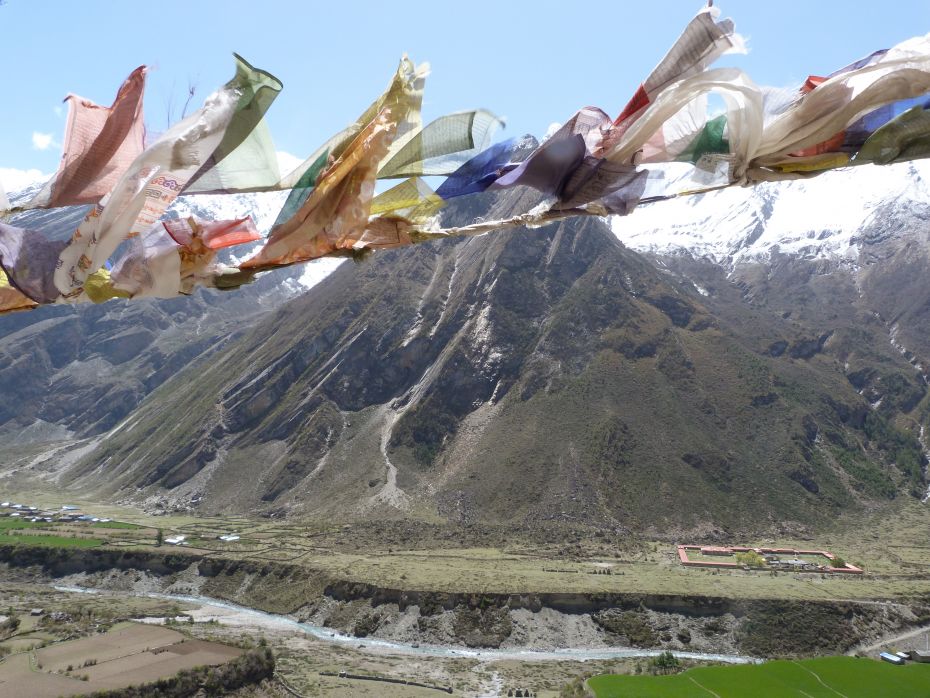
Frayed prayer flags flying over Tsum, Nepal, May 2018. Photo by Tsum pilgrimage participant.
In the remote borderlands of the high Himalayas, several valleys are said to be beyul—hidden or secret valleys—only open to those with very pure minds and hearts. According to ancient scriptures, they were established by Guru Rinpoche, the 8th-century Indian saint credited with spreading Buddhism into the Himalayas and Tibet.
In the 17th century the Tsum valley that branches off the Buri Gandaki River towards the north of Ganesh Himalaya (Mountain) in upper Gorkha District, Nepal, was named Beyul Kyimolung. Perhaps one of Nepal’s most beautiful valleys, it is cut off from the southern lowlands of Nepal by deep, forested gorges and swift rivers, and from Tibet in the north by snow-covered passes.
In May 2018 a group of twenty-two pilgrims, including Losang Dragpa Center resident teacher Geshe Jampa Tsundu, Tsum Project coordinator and former Rinchen Jangsem Ling secretary Low Yuet Kiew (“YK”), and FPMT Southeast Asia regional coordinator Selina Foong traveled together to Tsum, Nepal. Here, Selina shares her experience of the pilgrimage.
When I first heard that my friend YK, who is a member of two FPMT centers in Malaysia—Losang Dragpa Centre and Rinchen Jangsem Ling—was organizing a trip to the hidden valley of Tsum, Nepal, my hand shot up so fast that I just about dislocated my shoulder. Only later did random thoughts start to niggle. Will the helicopter ride cost a fortune? What sort of altitude are we talking about? The last time I hiked up any mountain (more like a hill by Nepal standards) was several years ago—how will my knees, now thrashed, hold up?
All doubts dissipated as our departure date neared. The time has come for sheer excitement! Final trip arrangements, lunch at Khachoe Ghakyil Ling Nunnery in Kathamandu, Nepal, a trial climb up to 2,700 meters (8,858 feet) altitude outside Kathmandu, kora at Boudha Stupa, and two peaceful nights in Kopan Monastery brought us to the day, Thursday, May 10, 2018, when we left the world behind and entered a blessed realm filled with riches far beyond our imagination.
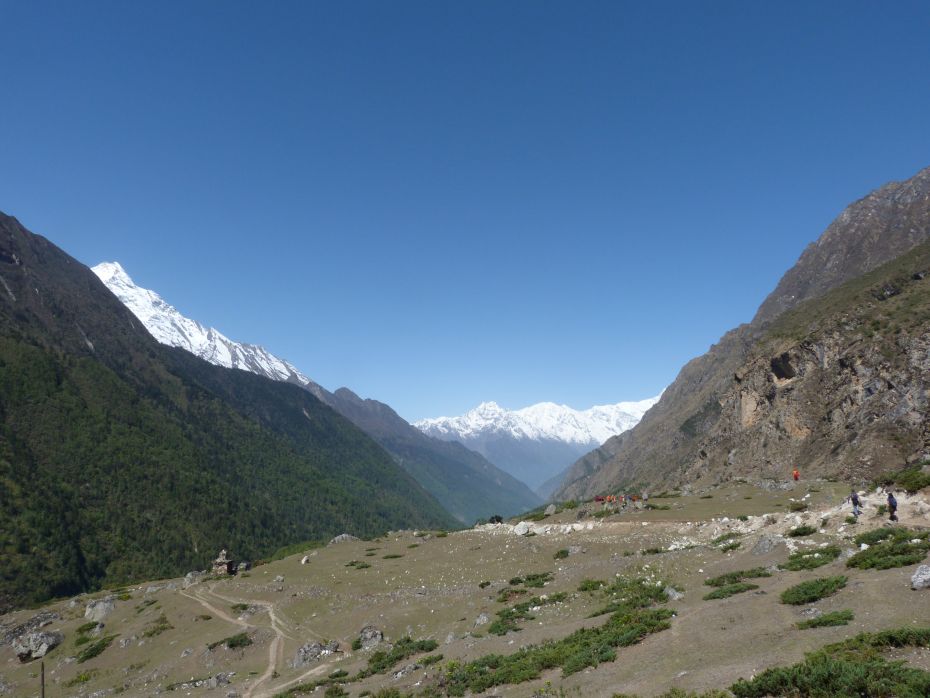
Tsum, Nepal, May 2018. Photo by Tsum pilgrimage participant.
Ethereal waterfalls tumbling down rugged mountains so steep they were just about vertical. Jagged snowy peaks luminous from the rays of the sun as far as the eye could see. A lone eagle of majestic wing span, slowly soaring over the vast valley below. Holy caves latent with the enlightened energy of past meditators, including Milarepa and Geshe Lama Konchog. The inspiring spirituality and genuine kindness of virtually everybody we met. Simply recalling all this is making my heart ache with the sweetest yearning.
It took four helicopters to ferry twenty-two of us from Kathmandu to Tsum. They were not kidding about strict weight controls. Only 10kg (22 lbs) of luggage each, which really wasn’t much considering that we would be staying at Rachen Nunnery in Tsum for one week. Inevitably, manic and desperate curtailing went on in many a Kopan bedroom the night before departure!
I will never forget my first sight of Rachen Nunnery. With jaws already slack from forty minutes of gaping at one spectacular mountain after another, Geshe Jampa Tsundu suddenly exclaimed, “Look! Rachen!”
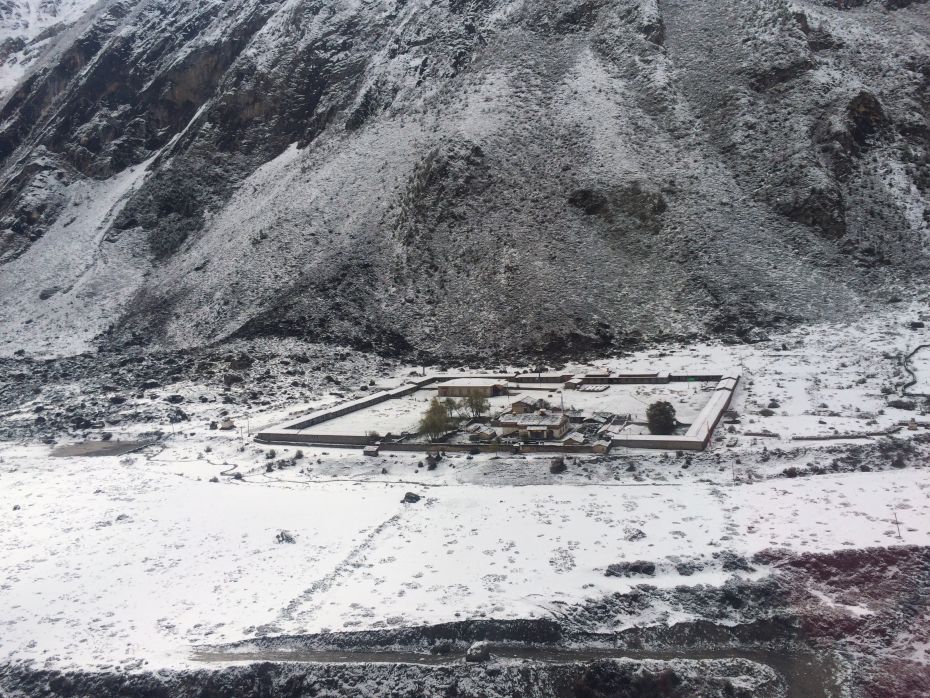
Rachen Nunnery seen from a helicopter, Tsum, Nepal, May 2018. Photo by Tsum pilgrimage participant.
Geshe-la was almost as excited as we were! It had been several years since he himself was there as resident teacher, and he was so looking forward to seeing all the monks and nuns again.
I stared into the distance. “Yes, I see it!” A low flat structure laid out in a huge square sharply contrasted against an expansive white wonderland. After years of hearing, reading, and talking about this place, I could hardly believe that we were actually about to land in it.

Landing at Rachen Nunnery, Tsum, Nepal, May 2018. Photo by Tsum pilgrimage participant.
With my first step out of the helicopter I got a jolt. It was cold! The morning’s snowfall had turned into freezing drizzle by the time my helicopter (number three) landed. An auspicious welcome no doubt, but this blast of cold after the Kathmandu heat sent shock waves through my undoubtedly tropical heart.
Greetings, khatas, shouts of delight,—then we all hurried along into the warmth of the dining room for very hot tea. And so passed our first day at Rachen.
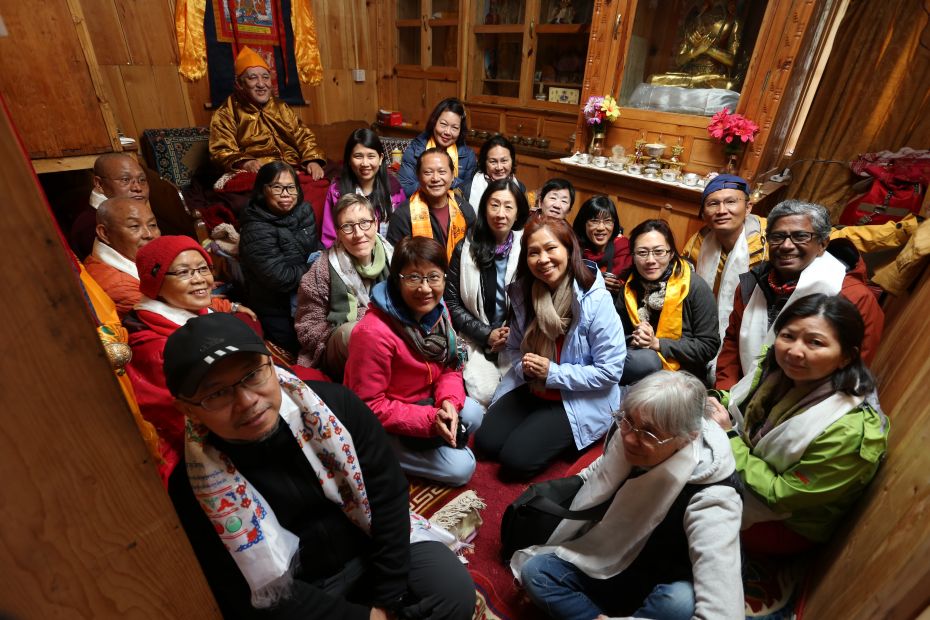
Pilgrimage group with Drukpa Rinpoche, Tsum, Nepal, May 2018. Photo by Tsum pilgrimage participant.
Among a blur of happiness and wonder was a group audience with Drukpa Rinpoche, who in his past life had founded both Mu Monastery and Rachen Nunnery. This was an unexpected bonus, as Rinpoche normally resides in India these days and “just happened” to be at Rachen. How wonderful!
We also toured the extensive nunnery grounds, which included the original and new gompa buildings, as well as an evocative house built by Geshe Lama Konchog himself.
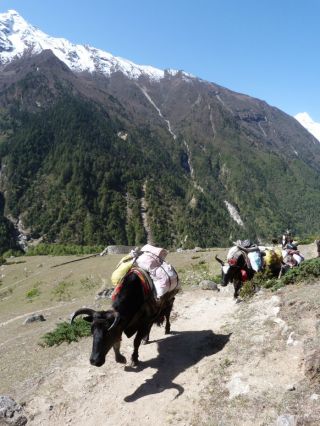
Yak carrying loads up a trail, Tsum, Nepal, May 2018. Photo by Tsum pilgrimage participant.
And on both sides of this flat valley, towering mountains pushed ever upwards into a wide open sky.
Natural splendor aside, the harshness of everyday life was also evident. Food had to be grown at the nunnery grounds or picked from the wild, and occasional one-day walks through the mountains into Tibet were necessary in order to obtain more groceries.
To keep warm, firewood had to be gathered from the nearby jungles (“nearby” being a relative term in Nepal) and hauled back to the nunnery. There was only solar energy to rely on, so needless to say, cloudy days meant icicles in the shower for those foolhardy enough to make the attempt.
Our second day dawned bright and clear, and we joined the nuns in their daily Tara Puja before setting off on our first hike.
First up, Milarepa’s Cave of the Doves! Here, dakinis had transformed into doves in order to listen to the Dharma from Milarepa. There were three separate but adjacent parts—a meditation gompa, a small cave with his very clear footprint on a large rock, and another small gompa with holy statues.
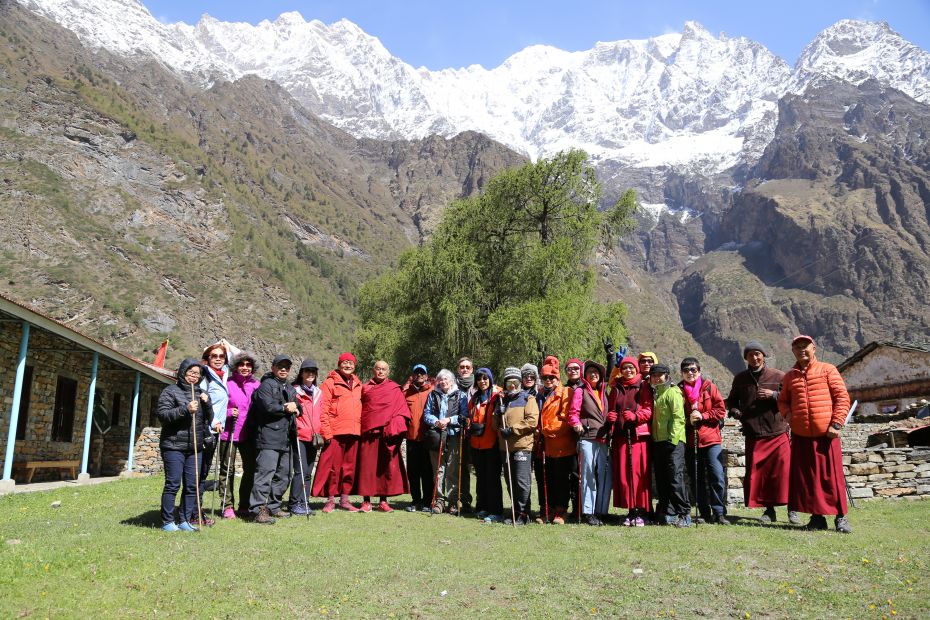
Leaving from Rachen Nunnery for the first hike, to Milarepa Cave of Doves, Tsum, Nepal, May 2018. Photo by Tsum pilgrimage participant.
How moving to peer out from those dim tiny spaces towards the endless snowy peaks beyond, and realize that the great saint Milarepa would have done much the same centuries ago, as he meditated on the nature of reality! Galvanized and inspired, I recalled this beautiful line from Calling the Lama from Afar: “Magnificently glorious guru, please bless me to abide one-pointedly in practice in isolated places, not having any hindrances to my practice.”
On our way down, we stopped at another holy cave. Here, the great yogi Geshe Lama Konchog had meditated. Gazing at the piles of stones and then further into the darkness, the tranquility was palpable.
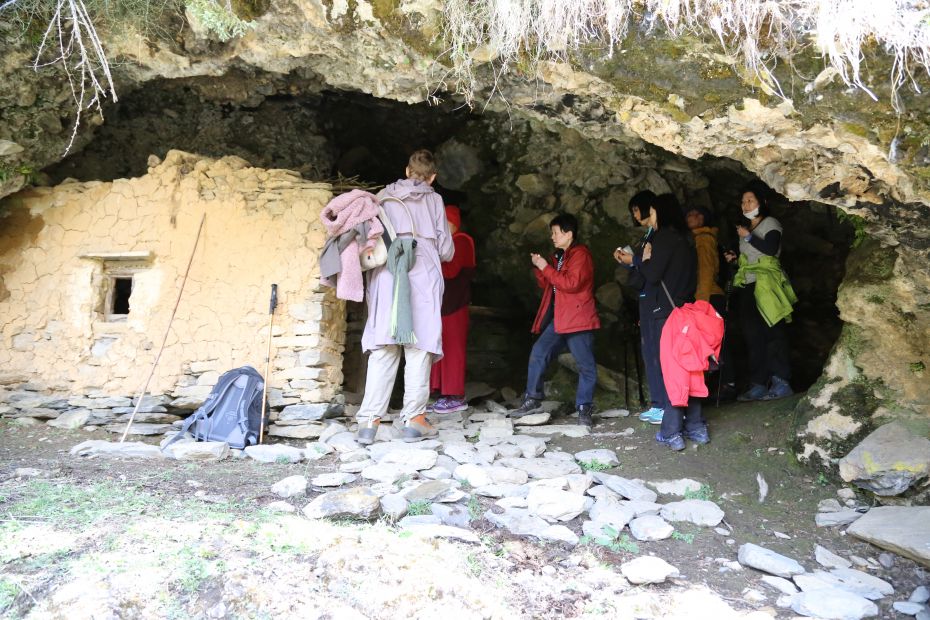
Visiting Geshe Lama Konchog’s retreat cave below Milarepa’s Cave of Doves, Tsum, Nepal, May 2018. Photo by Tsum pilgrimage participant.
As it turned out, these holy places had a way of suspending the normal passage of time in more ways than one. As we trekked back and looked at our watches, we were suddenly startled. What was to have been an easy walk this morning had turned into a five-hour expedition! Whoops! Blame it on all the posing and photos!
We sped up, got back, gulped down our very late lunch, then changed into brand new orange TSUM t-shirts for the grand opening of the Library of Nalanda Wisdom for Rachen Nunnery, an electronic library consisting of iPads and tablets that each of us had carried to Tsum from Kuala Lumpur, Malaysia, fully loaded with prayers and teachings. The nuns were so excited! What a happy afternoon it was, with speeches, laughter, applause, balloons, balloons, and yet more balloons.
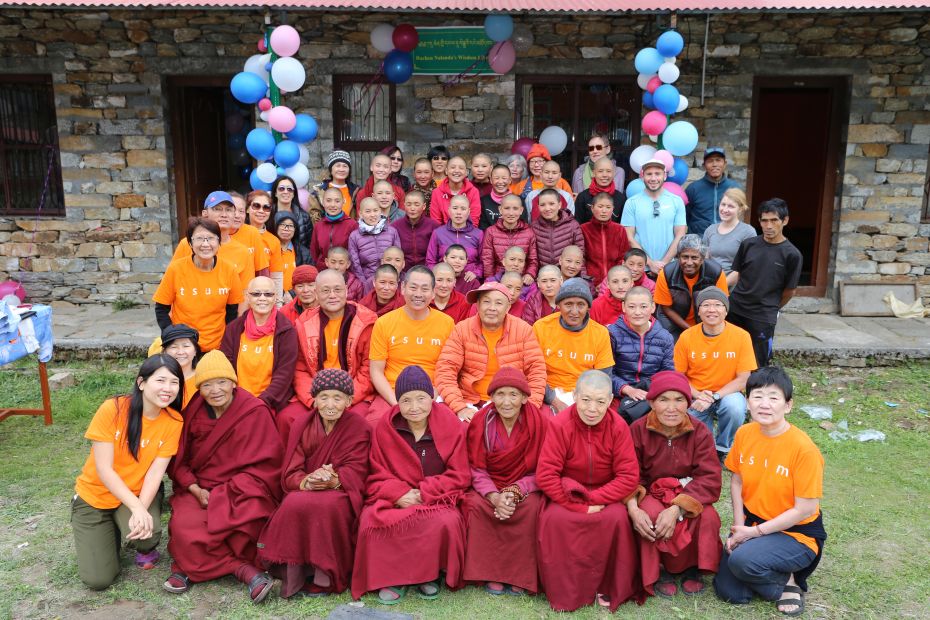
Grand opening of the electronic library at Rachen Nunnery, Tsum, Nepal, May 2018. Photo by Tsum pilgrimage participant.
A good night’s sleep set us up to walk three times further the next day.
Big excitement—we were going to Apey and Mochung’s house for lunch! Parents of both Tenzin Phuntsok Rinpoche (the reincarnation of the late Geshe Lama Konchog) and Thubten Rigsel Rinpoche (the reincarnation of the late Khensur Rinpoche Lama Lhundrup Rigsel), they were so endearingly kind, bending over backwards to return early to Tsum from Kathmandu, just to meet us and cook a huge lunch for us all.
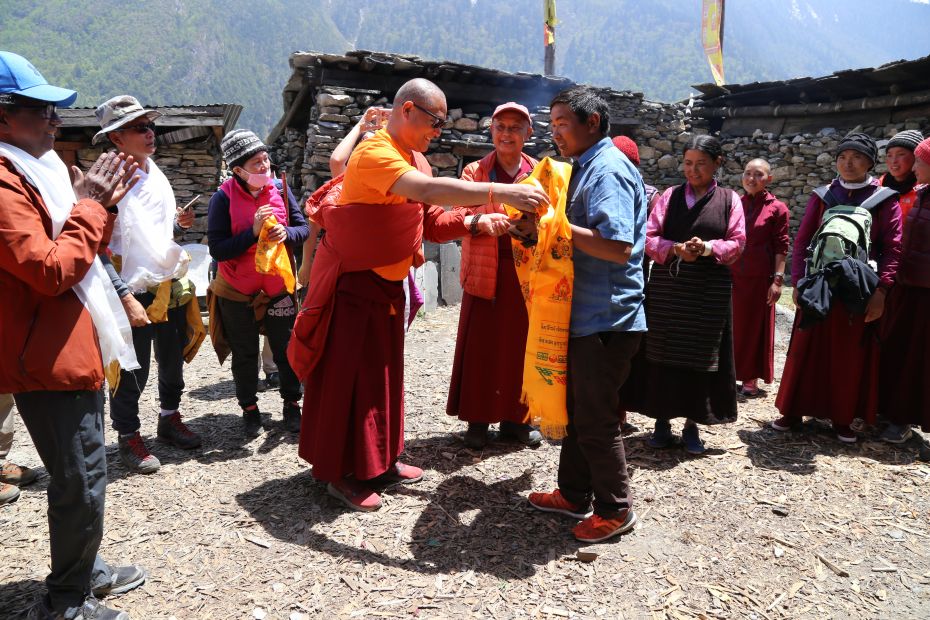
Geshe Jampa Tsundu thanking Apey and Mochung after lunch, Tsum, Nepal, May 2018. Photo by Tsum pilgrimage participant.
By the time this feast was over, however—and no doubt recalling our dismal pace yesterday—both Geshe Tsundu and Gen Tenpa Choeden decided that we would never make it to the Geshe Lama Konchog retreat cave Gaden Gompa behind Apey and Mochung’s house and be back at the nunnery before nightfall. Disappointment all round! But we were also grateful that they were so concerned for our safety.
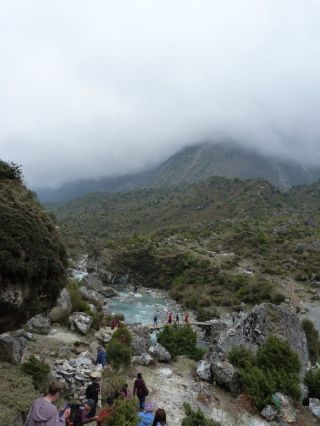
Hiking in Tsum, Nepal, May 2018. Photo by Tsum pilgrimage participant.
In any case, the trek back to Rachen was gorgeous as we took a different route through the jungles and then along the river, accompanied by strains of “Hala Hala ling ling chura chura ling ling! Hara hara ling ling!” sung by our jolly companion nuns.
By the time we all trekked (or staggered) back to the nunnery, our dear lamas must have taken pity on us. We probably looked truly bedraggled! And so it was declared: our program would be adjusted to allow the next day to be free and easy.
This was music to our ears! It also posed a golden opportunity for a few energetic and kiasu pilgrims—six of us to be exact.
Cornering Geshe Tsundu that evening, he finally agreed to lead us back the very next day to Gaden Gompa, where Geshe Lama Konchog had meditated for many years and completed 2,000 nyung nä retreats. But there were two conditions: we had to walk fast this time, and we could not stop every ten seconds to take photos! Like excited children, we agreed. Which was why the very next day, the six of us trotted off along with our Sangha guides at 7:46 a.m. sharp and obediently kept up the pace with military precision.
It turned out to be a very special day. The magnitude of the places we would be visiting that day was not lost on me, and I had made fervent prayers before leaving that we would have the karma to complete the day’s pilgrimage without mishap.
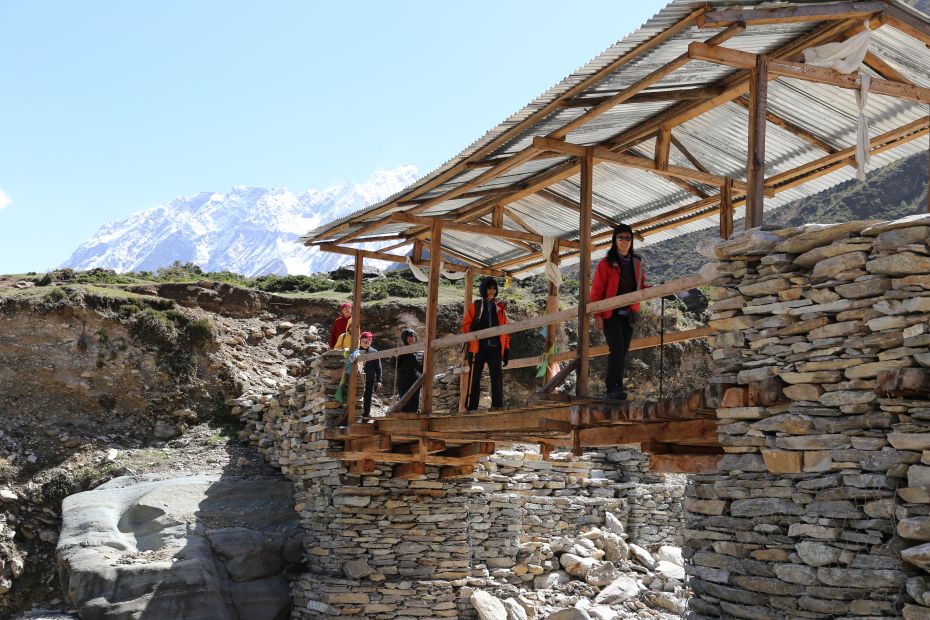
Hiking in Tsum, Nepal, May 2018. Photo by Tsum pilgrimage participant.
Finally, after an arduous climb, we arrived. All chatter stopped; a gentle hush fell.
As we entered the Geshe Lama Konchog retreat cave Gaden Gompa, I thought of every sentient being—all of them having played a role in bringing me to this point, in this life—and felt overwhelming gratitude toward them all. This experience was only possible in dependence upon all others, and so it was for all others that I experienced it.
Khata after khata was offered, as I also thought about all my dear Dharma friends and travel companions who did not make it that day. We spent a long time there inside the small hut as well as the open area behind it, where Geshe Lama Konchog’s robes and belongings remain sealed in a stone vault. Geshe Tsundu led the prayers and meditation before we finally hung our prayer flags and departed.
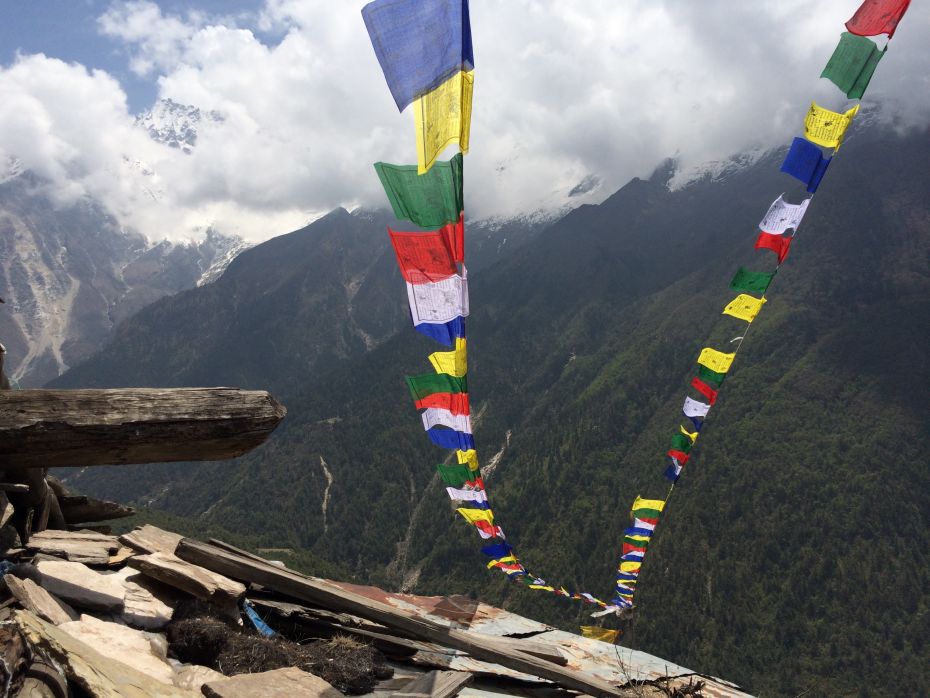
View from Geshe Lama Konchog’s retreat hut Gaden Gompa, Tsum, Nepal, May 2018. Photo by Tsum pilgrimage participant.
Thinking that was it, Geshe Tsundu was about to lead us back down for lunch and the return journey. But after this extraordinary experience, it was plain we were keen for more! In the end, it didn’t take much convincing for Geshe-la as well as Apey to lead us to the Hayagriva cave further along the mountain.
We took turns entering the small cave, where a tiny creek flowed, and an amazing self-emanating torma in a deep shade of red was clearly evident on the rocks. Wow! We had to spread ourselves out flat on the rocks in order to reach the torma and taste some of the holy water. What wonderful blessings!
We returned to Rachen with our hearts singing and bellies filled to the brim after a late lunch at dear Apey and Mochung’s house (again!). It was a merry reunion with everyone in the dining room that evening, as we all recounted the day.
Some had returned to the second Geshe Lama Konchog cave below Milarepa’s Cave of the Doves to spend several happy hours. Others trekked to a nearby village shop, to stock up on basic groceries for the nuns, before returning to cook up a feast for everyone. The fried rice tasted amazing!
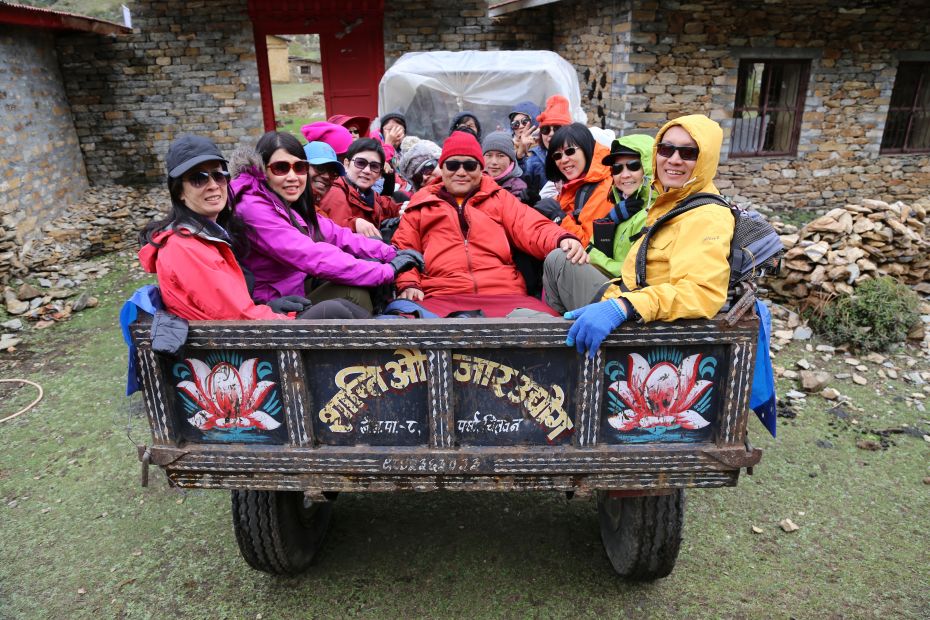
Tractor and trailer ride, Tsum, Nepal, May 2018. Photo by Tsum pilgrimage participant.
Which brings us to our second to last day in Tsum—the day of the tractor. It was a day none of us would ever forget.
Tractor? Yes, tractor. And us in a trailer, with no suspension, pulled by said tractor. Us, meaning approximately twenty not particularly tiny people. Why on earth? Because it was raining solidly from 3 a.m., and there was no way we were going to hike the 30 kilometers (19 miles) round-trip up to Mu Monastery and back in a single day, let alone in cold wet conditions. Nothing for it. As Gen Tenpa Choeden announced, “Die die also must go!”
This got me thinking that Mu Monastery, at an altitude of 3,700 meters (12,139 feet) and in the same direction as Tibet, must really be a fantastically special place.
Oh, the obstacles we encountered in trying to visit Mu! Already postponed twice, it almost looked like we would not be able to go at all—until this tractor and trailer combination (more glamorously referred to as the “Ferrari” by YK) came to our rescue.
In actual fact, “rescue” was the last thing that came to mind. As we banged and crashed through impossible terrain, including wild rivers complete with rocks and raging rapids, at times mere inches from steep ravine edges, it was quite a wonder that we didn’t get transported right into our next lives instead.
There we were—hollering and yowling, sometimes in fits of laughter and other times in sheer terror—squashed together like sardines and getting flung around like rag dolls. Such retrospective fun! Wonderful collective karma, right travel buddies?
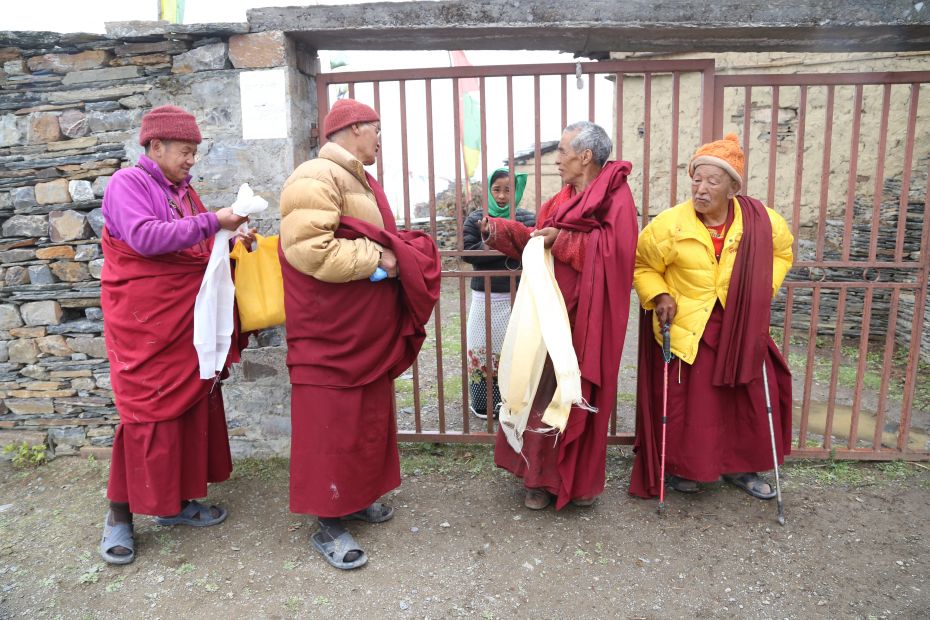
Mu Monastery monks awaiting the pilgrims’ arrival, Tsum, Nepal, May 2018. Photo by Tsum pilgrimage participant.
But it was so worth it. Mu Monastery was indeed special. Old and isolated, it was like nothing I had ever experienced. Under leaden skies, heavy mist, and enveloped by sharp cold air, I found myself floating in a dream-like world belonging to a different time.
The elderly resident monks were into their first day of the annual Saka Dawa nyung nä retreat in their dark and evocative gompa. We will forever be grateful to have been a small part of it all.
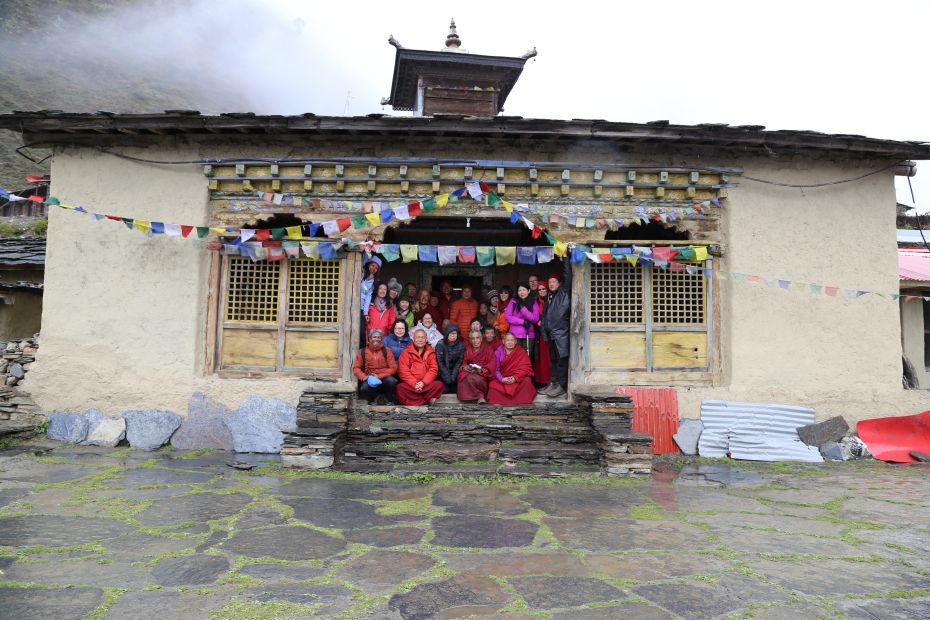
Mu Monastery gompa, Tsum, Nepal, May 2018. Photo by Tsum pilgrimage participant.
A fitting end to our stay at Tsum was joining the Rachen nuns on the second day of their own nyung nä retreat. As we evoked One-Thousand Arm Avalokiteshvara in this beautiful practice, I prayed for the holy Dharma to flourish in this and all worlds. May the lives of our gurus be long and healthy. May they return to teach us over and over again, until samsara is utterly emptied of all beings.
A big thank you to Gen Tenpa Choeden, Geshe Tsundu, Geshe Nyima, all the Sangha at Rachen Nunnery, Mu Monastery, Khachoe Ghakyil Ling Nunnery, Kopan Monastery, Tsum Project coordinator YK, and all my wonderful travel companions. And a special mention to Geshe Tenzin Zopa, original Tsum Project coordinator and former resident geshe at Losang Dragma Center, who was so instrumental behind the scenes in ensuring that this would be a trip for us to remember for the rest of our lives.
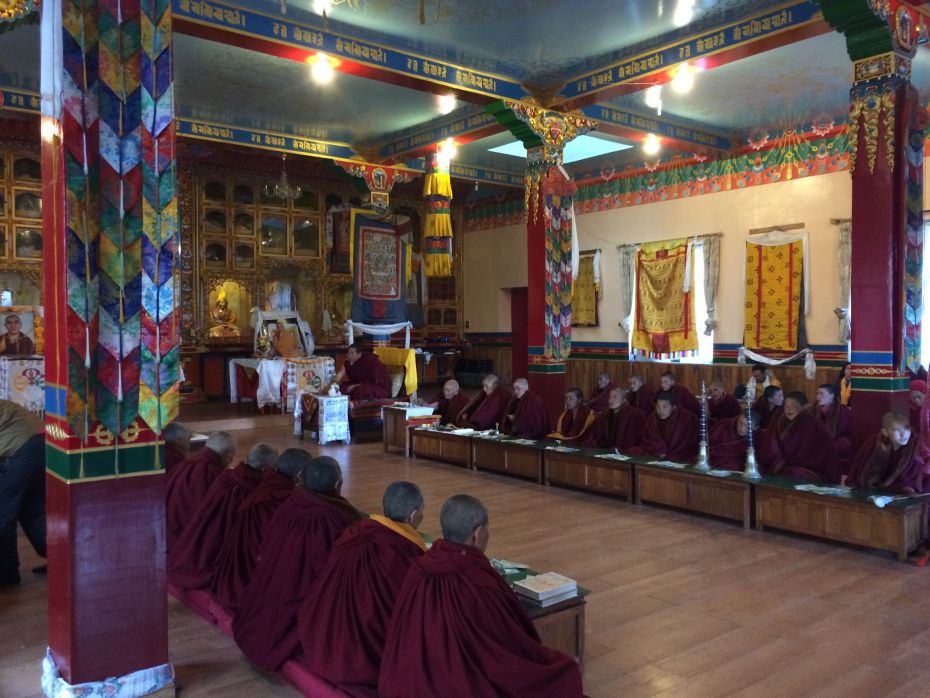
Rachen Nunnery’s new gompa, Tsum, Nepal, May 2018. Photo by Tsum pilgrimage participant.
Here’s to our next pilgrimage. And we’d better choose somewhere cold so that we can all wear the new Marmot gear we amassed upon our return to Kathmandu!
Read Lama Zopa Rinpoche’s advice for pilgrimage:
https://fpmt.org/wp-content/uploads/teachers/zopa/advice/Pilgrimage_Advice.pdf
- Home
- News/Media
- Study & Practice
- About FPMT Education Services
- Latest News
- Programs
- New to Buddhism?
- Buddhist Mind Science: Activating Your Potential
- Heart Advice for Death and Dying
- Discovering Buddhism
- Living in the Path
- Exploring Buddhism
- FPMT Basic Program
- FPMT Masters Program
- FPMT In-Depth Meditation Training
- Maitripa College
- Lotsawa Rinchen Zangpo Translator Program
- Universal Education for Compassion & Wisdom
- Online Learning Center
- Prayers & Practice Materials
- Overview of Prayers & Practices
- Full Catalogue of Prayers & Practice Materials
- Explore Popular Topics
- Benefiting Animals
- Chenrezig Resources
- Death & Dying Resources
- Lama Chopa (Guru Puja)
- Lama Zopa Rinpoche: Compendium of Precious Instructions
- Lama Zopa Rinpoche: Life Practice Advice
- Lama Zopa Rinpoche Practice Series
- Lamrim Resources
- Mantras
- Prayer Book Updates
- Purification Practices
- Sutras
- Thought Transformation (Lojong)
- Audio Materials
- Dharma Dates – Tibetan Calendar
- Translation Services
- Publishing Services
- Teachings and Advice
- Find Teachings and Advice
- Lama Zopa Rinpoche Advice Page
- Lama Zopa Rinpoche: Compendium of Precious Instructions
- Lama Zopa Rinpoche Video Teachings
- ༧སྐྱབས་རྗེ་བཟོད་པ་རིན་པོ་ཆེ་མཆོག་ནས་སྩལ་བའི་བཀའ་སློབ་བརྙན་འཕྲིན།
- Podcasts
- Lama Yeshe Wisdom Archive
- Buddhism FAQ
- Dharma for Young People
- Resources on Holy Objects
- Ways to Offer Support
- Centers
- Affiliates Area
- Teachers
- Projects
- Charitable Projects
- Make a Donation
- Applying for Grants
- News about Projects
- Other Projects within FPMT
- Support International Office
- Projects Photo Galleries
- Give Where Most Needed
- FPMT
- Shop
Translate*
*powered by Google TranslateTranslation of pages on fpmt.org is performed by Google Translate, a third party service which FPMT has no control over. The service provides automated computer translations that are only an approximation of the websites' original content. The translations should not be considered exact and only used as a rough guide.When you meet miserable conditions, it is extremely important to use skillful means. In other words, there is a meditation to mix with whatever suffering you experience. When you apply the teachings in this way, all sufferings are mixed with virtue. All experiences of suffering become virtue.







